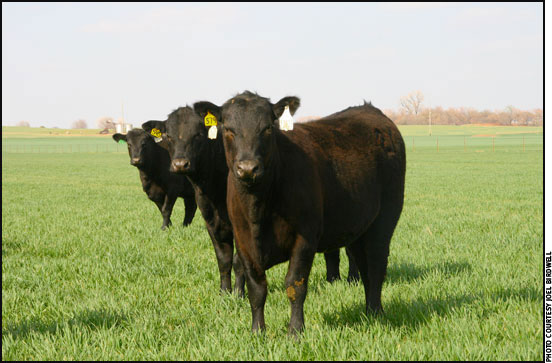Has Wheat Reached
Hollow Stem Stage?
Early spring growth determines wheat management practices.
As soon as wheat begins its first flush of growth in late winter or early spring, producers might want to start examining plants to determine if the wheat has reached the "first hollow stem" stage, said Jim Shroyer, K-State Research and Extension crop production specialist. This is especially important if planned nitrogen has not yet been top-dressed or if the wheat is being grazed.
First hollow stem is the point at which about a half-inch of hollow stem can first be identified above the root system and below the developing head, Shroyer explained. This early stage of spring wheat growth will occur between a few days and a week or more prior to jointing, depending on temperatures, and it won't be obvious without doing a little investigating, he said.
"First hollow stem occurs when the developing head is still below the soil surface. To find out if the wheat is at this stage, producers will need to dig up some plants from fields that have not been grazed. Select the largest tillers to examine, cut off the top of the plant a couple inches above the soil surface. Then slice the stem open from the crown area up," Shroyer detailed.
"Look for the developing head, which will be very small," he continued. "Next, see if you can find any hollow stem between the developing head and the crown area. If there is any separation between the growing point and crown, the wheat plant is at first hollow stem."
Why go to all this trouble? The first reason has to do with top-dress fertilizer timing, Shroyer said.
"At this stage of growth, the growing point will soon begin to develop a tiny head. This is when the maximum potential number of spikelets is determined. Producers should make sure that sufficient nitrogen is available in the root zone at this growth stage in order to avoid limiting the number of seeds per head," the K-State agronomist said.
The second reason has to do with the effects of cattle grazing on grain yields at this stage of growth, he added.

"Once the wheat has reached first hollow stem, cattle should be removed to prevent grain yield loss. Yield losses from grazing after first hollow stem may be up to one-and-one-quarter bushels per day, according to Oklahoma State University data," he said. "Although losses may not be this great for the first few days of grazing after first hollow stem, those losses become greater the longer you go because more tillers will be present."
Two things happen when wheat is grazed too long, Shroyer said. There will be fewer heads per acre because the primary tiller has been removed, and heads will be smaller and lighter than expected because leaf area has been removed, he concluded.











